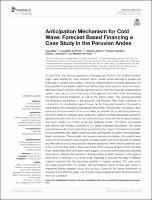Anticipation Mechanism for Cold Wave: Forecast Based Financing a Case Study in the Peruvian Andes
Autor(es)
Fecha
2021-11Colecciones
- Artículo científico [171]
Recurso(s) relacionado(s)
https://www.frontiersin.org/articles/10.3389/fclim.2021.747906/fullResumen
In June 2018, the Peruvian provinces of Arequipa and Puno in the southern Andean region were affected by heavy snowfall, which caused severe damage to people and livelihoods in several communities. Using the Forecast-based Financing approach, the Peruvian Red Cross implemented its pre-defined early action protocol before this event, after receiving an extreme snowfall warning (Level 4) from the Peruvian meteorological service. Here, we provide a case study of the approach and event itself, documenting the decision-making thresholds as well as the actions taken. This warning activated the thresholds established in the protocol, and Peruvian Red Cross prioritized 10 communities for pre-disaster support based on the forecasted severity of the event in combination with vulnerability and exposure information. The activation took place 2 days before the extreme snowfall in the communities, and the Red Cross distributed veterinary kits for 50 heads of cattle per family, tarpaulins, tool kits to install a temporary awning for alpacas to protect them from the cold wind and snow, protection kits for alpaca herders and warm clothing for children under five, pregnant women, the elderly, and people with chronic and infectious diseases in 430 highly vulnerable households. This article presents the results of a household survey following the impact of the extreme snowfall. We document the early actions taken by these communities to protect their livelihoods, health, and assets. The evaluation also presents descriptive statistics of household-level outcomes for households receiving pre-snowfall support and those that did not receive any intervention or only received post-disaster assistance. While most households took action to protect their assets, there were fewer extreme losses of alpaca herds reported in the communities who received the early support, and these communities also reported fewer adults suffering from respiratory illnesses. More in-depth research on this type of early action is necessary on a wider scale, especially to evaluate the utility of different support measures and the necessary quantity of support needed. This case study can inform government, civil society, and humanitarian actors of how early action is happening before disasters occur and provide a direction for further investment in research and practice to make use of hydro-meteorological forecasts for the benefit of the most vulnerable. Copyright © 2021 Bazo, de Perez, Jacome, Mantilla, Destrooper and Van Aalst.
El ítem tiene asociados los siguientes ficheros de licencia:








